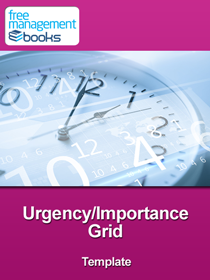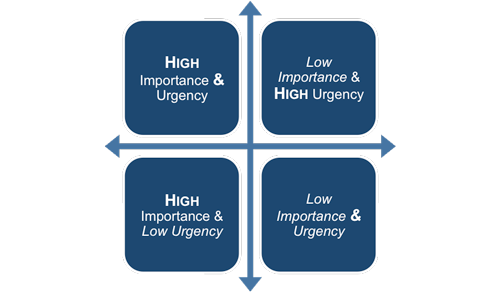
Urgency/Importance Grid Template
This Urgency/Importance Grid template provides you with a quick and easy way to prioritize each of your outstanding tasks according to their relative urgency and importance.
Every successful manager seems to have an innate skill in deciding which of their tasks to action first and which to discard, but this is not the case. They have just learnt through practice how to discern which of their tasks is important and the level of urgency attached to it. This worksheet template is designed along the classical grid layout so that you can easily add tasks into one section and move them to another as their importance or urgency alters as other tasks are taken into account.

If one or more of your tasks do not fit into one of the four quadrants of the urgency and importance grid then you need action then in one of two ways:
• Discard it and offer an explanation for this action.
• Avoid accepting it on your workload and take positive steps to cease receiving requests to perform such tasks.
There are only a limited number of hours in your working day and ensuring that these are used effectively and efficiently is the aim of every manager. Using the urgency and importance grid worksheet will enable you to quickly isolate those tasks you should be focusing on and those you should plan to do later. It also allows you to see those tasks, which have no place in your own grid and therefore need to be outsourced or deleted from your work schedule.
A critical aspect for ensuring you portray the right image to your seniors, in terms of your efficiency, is your ability to manage their expectations of what you can achieve. This also includes other groups of people you interact with, such as, your team, suppliers, customers, agencies and other managers within your organization.
You have been assigned certain goals to achieve and these should always be at the forefront of your mind when filling in this worksheet. Making sure that you communicate clearly with these individuals will ensure everyone understands what they need to contribute to achieve success. There will always be times when exceptions have to be made and the stress of such short-term situations turns the challenge into a motivational boost.
This does not mean you rigidly protect your work schedule, as part of the modern customer focused organizations it is essential that every person is flexible and adaptive in how they perform their role. You need to be quietly assertive in managing your own workload to minimize long-term stress. It is important that you do not portray an aggressive image when being assertive. This is best avoided by actively listening to those around you so that you can empathize with them but not get dumped on!
Each quadrant of the urgency and importance grid worksheet offers you a way of handling the tasks that fall into it.
- Tasks of High Importance & High Urgency – these tasks need to be actioned ASAP. This means that they probably need to be done today and to a high standard. Communicating with the end customer is essential so that their expectations can be managed.
- Tasks of High Importance & Low Urgency – these tasks will have the common factor of being ‘long-term’ in their nature. The first thing you need to do is make sure that its aim or goal is set and SMART as these tasks will be how your success is judged. Then it is likely that the best way to manage these tasks is to break it down into manageable chunks of your time.
- Tasks of Low Importance & High Urgency – these tasks are ones that frequently divert managers from those on the left-hand side of the grid. So while they need to be completed on time, the time you allocate to its performance needs to be minimal and sufficient.
- Tasks of Low Importance & Low Urgency – don’t waste time procrastinating over such tasks deal with them quickly and efficiently. There are three ways to do this.
1) Delegate to someone who will find it challenging, but remember you own the task so it must be monitored.
2) Discard it giving an explanation as to why it is not appropriate for you to action and describe the potential harm it could cause to your other tasks of high importance. Make sure that the requester of such tasks appreciates and accepts your assessment of it and agrees there is a better way to achieve what they want.
3) Avoid accepting it onto your action list, explaining why you are rejecting it and offer a better alternative way of accomplishing the task. These are often referred to as ‘habitual comforters’, which aren’t really true tasks. Such unproductive tasks if taken on board will be de-motivating and counter-productive to your productivity.
Use this worksheet to ensure that you are someone who spends most of your time working on the top row of the urgency and importance grid so that you are proactively managing your own success. Don’t find yourself doing tasks out of habit and because the task requester is the one shouting at you the most and loudly.
There is little doubt that managing expectations is an essential skill for every manager. You may find our template the urgency and importance grid on this page helpful in enabling you to prioritize and plan your workload to maximize your productivity. Following the tips provided here will enable you to do just that and stay focused on what you do best.
